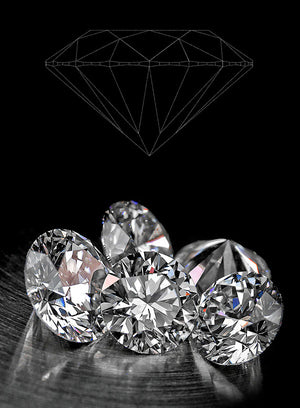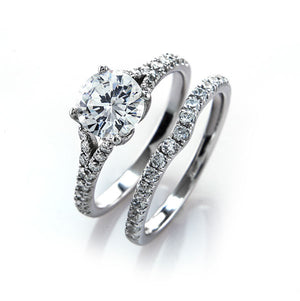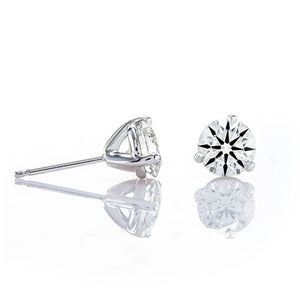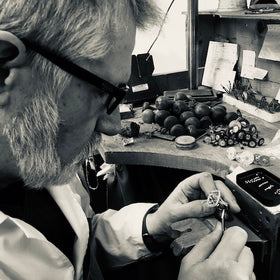
Are VS2 - SI1 diamonds always "eye clean"?
This is a continuation of the blog post, Brian Gavin Blue vs Hearts and Arrows. Within which Jason asked a series of questions, including whether all of our SI-1 and VS-2 clarity diamonds are eye-clean.
Whether or not a diamond is “eye clean” is somewhat objective given the individual nature of human vision. However, it will be helpful to better understand the general guidelines used to determine whether or not a diamond is eye-clean.
 Under those conditions, this 1.01 carat, F-color, SI-1 clarity, Brian Gavin Signature diamond is eye-clean. At the same time, the cluster of crystals, clouds, and needle inclusions are readily and immediately visible in the clarity photograph to the left.
In the first place, it’s important to realize that the diamond in this example has an average outside diameter of 6.42 mm, which is a little smaller than the diameter of the pink eraser on a standard #2 yellow pencil. The fact of the matter is that this clarity photograph shows the diamond at about 35x magnification. Needless to say, everything looks bigger than life under those conditions.
At the same time, it’s important to realize that the visibility of inclusions can vary depending on the viewing conditions. Slight differences in the lighting environment, or whether the diamond is wet or dry can have a major impact on our ability to see the inclusions within a diamond.
In addition, it’s important to account for differences in the individual vision of the person viewing the diamond. Of course, the inclusions might also be visible to some degree when the diamond is scrutinized at a closer distance, or if somebody has sharper vision.
With this in mind, it might be easier for some people to see the inclusions within SI-1 and lower clarity diamonds with just their eyes. However, other people might look at the same diamond and not be able to see the inclusions without magnification. If you want to play it safe, then we recommend buying a diamond which is VS-2 or higher in clarity.
Under those conditions, this 1.01 carat, F-color, SI-1 clarity, Brian Gavin Signature diamond is eye-clean. At the same time, the cluster of crystals, clouds, and needle inclusions are readily and immediately visible in the clarity photograph to the left.
In the first place, it’s important to realize that the diamond in this example has an average outside diameter of 6.42 mm, which is a little smaller than the diameter of the pink eraser on a standard #2 yellow pencil. The fact of the matter is that this clarity photograph shows the diamond at about 35x magnification. Needless to say, everything looks bigger than life under those conditions.
At the same time, it’s important to realize that the visibility of inclusions can vary depending on the viewing conditions. Slight differences in the lighting environment, or whether the diamond is wet or dry can have a major impact on our ability to see the inclusions within a diamond.
In addition, it’s important to account for differences in the individual vision of the person viewing the diamond. Of course, the inclusions might also be visible to some degree when the diamond is scrutinized at a closer distance, or if somebody has sharper vision.
With this in mind, it might be easier for some people to see the inclusions within SI-1 and lower clarity diamonds with just their eyes. However, other people might look at the same diamond and not be able to see the inclusions without magnification. If you want to play it safe, then we recommend buying a diamond which is VS-2 or higher in clarity.
 As a matter of fact, it’s pretty rare to find a VS-2 clarity diamond that is not eye clean from a top down perspective. With that in mind, it’s a pretty safe bet that any VS-2 clarity diamond you select from Brian Gavin is going to be “eye clean” unless you have some kind of super-powered eagle vision.
At first glance, it’s clearly evident that the inclusions within this 1.051 carat, I-color, VS-2 clarity, Brian Gavin Signature diamond are less apparent than they are in the SI-1 clarity diamond from above. Of course, this makes perfect sense because VS-2 represents a higher spectrum of clarity than the SI-1 clarity grade. With that in mind, the inclusions should be more difficult to locate.
Be that as it may, we’re happy to provide you with an in-depth analysis of the inclusions within any diamond from our inventory. We’ll be happy to look at the diamond under a variety of lighting scenarios and let you know the extent to which the inclusions are visible with or without magnification.
As a matter of fact, it’s pretty rare to find a VS-2 clarity diamond that is not eye clean from a top down perspective. With that in mind, it’s a pretty safe bet that any VS-2 clarity diamond you select from Brian Gavin is going to be “eye clean” unless you have some kind of super-powered eagle vision.
At first glance, it’s clearly evident that the inclusions within this 1.051 carat, I-color, VS-2 clarity, Brian Gavin Signature diamond are less apparent than they are in the SI-1 clarity diamond from above. Of course, this makes perfect sense because VS-2 represents a higher spectrum of clarity than the SI-1 clarity grade. With that in mind, the inclusions should be more difficult to locate.
Be that as it may, we’re happy to provide you with an in-depth analysis of the inclusions within any diamond from our inventory. We’ll be happy to look at the diamond under a variety of lighting scenarios and let you know the extent to which the inclusions are visible with or without magnification.
How diamonds are graded for clarity:
Let’s begin by shedding some light on the process of grading diamonds for clarity. The first thing to understand is that diamonds are graded for clarity under laboratory conditions. Wherein the intent is simply to identify the inclusions and determine the extent of the characteristics. This means that a trained diamond grader evaluates the diamond using both their eyes and varying degrees of magnification. The industry standard for diamond clarity grading is 10x magnification. However, it is quite common for diamond graders to use higher degrees of magnification at the beginning of the analysis. This is especially true for higher clarity diamonds, such as those in the VVS-1 and VVS-2 spectrum. Diamond clarity grading is done from the face-up position. This means that diamonds are evaluated from the top-down vantage point and not from the sides. The facet structure of a diamond is designed to reflect light out through the top, so this makes sense. The high volume of light return and sparkle factor of your Brian Gavin Signature diamond will make it more difficult to see inclusions with just your eyes.The definition of “eye clean” diamond clarity:
As with most things in life, everything is a matter of perspective and subject to interpretation. This means that whether or not a diamond is “eye clean” is largely a matter of interpretation. With this in mind, it will be helpful to understand the industry's definition of eye-clean. In the first place, any reference to diamond clarity is always assumed to be from the perspective of top-down because that is how diamonds are graded. This means that inclusions might be readily and immediately visible from a side profile, even in higher clarity diamonds. Secondly, the process for determining whether a diamond is “eye clean” is to view the diamond from a distance of 9-12 inches. If the inclusions are not “readily and immediately visible” to a trained grader from that distance, then the diamond is deemed to be eye-clean. Under those conditions, this 1.01 carat, F-color, SI-1 clarity, Brian Gavin Signature diamond is eye-clean. At the same time, the cluster of crystals, clouds, and needle inclusions are readily and immediately visible in the clarity photograph to the left.
In the first place, it’s important to realize that the diamond in this example has an average outside diameter of 6.42 mm, which is a little smaller than the diameter of the pink eraser on a standard #2 yellow pencil. The fact of the matter is that this clarity photograph shows the diamond at about 35x magnification. Needless to say, everything looks bigger than life under those conditions.
At the same time, it’s important to realize that the visibility of inclusions can vary depending on the viewing conditions. Slight differences in the lighting environment, or whether the diamond is wet or dry can have a major impact on our ability to see the inclusions within a diamond.
In addition, it’s important to account for differences in the individual vision of the person viewing the diamond. Of course, the inclusions might also be visible to some degree when the diamond is scrutinized at a closer distance, or if somebody has sharper vision.
With this in mind, it might be easier for some people to see the inclusions within SI-1 and lower clarity diamonds with just their eyes. However, other people might look at the same diamond and not be able to see the inclusions without magnification. If you want to play it safe, then we recommend buying a diamond which is VS-2 or higher in clarity.
Under those conditions, this 1.01 carat, F-color, SI-1 clarity, Brian Gavin Signature diamond is eye-clean. At the same time, the cluster of crystals, clouds, and needle inclusions are readily and immediately visible in the clarity photograph to the left.
In the first place, it’s important to realize that the diamond in this example has an average outside diameter of 6.42 mm, which is a little smaller than the diameter of the pink eraser on a standard #2 yellow pencil. The fact of the matter is that this clarity photograph shows the diamond at about 35x magnification. Needless to say, everything looks bigger than life under those conditions.
At the same time, it’s important to realize that the visibility of inclusions can vary depending on the viewing conditions. Slight differences in the lighting environment, or whether the diamond is wet or dry can have a major impact on our ability to see the inclusions within a diamond.
In addition, it’s important to account for differences in the individual vision of the person viewing the diamond. Of course, the inclusions might also be visible to some degree when the diamond is scrutinized at a closer distance, or if somebody has sharper vision.
With this in mind, it might be easier for some people to see the inclusions within SI-1 and lower clarity diamonds with just their eyes. However, other people might look at the same diamond and not be able to see the inclusions without magnification. If you want to play it safe, then we recommend buying a diamond which is VS-2 or higher in clarity.
Are VS-2 clarity diamonds eye clean?
The vast majority of VS-2 clarity diamonds are “eye clean” from a top down perspective. I think that I’ve seen four over the years that contained an inclusion or two that I was able to locate with just my eyes after very careful examination of the diamond. As a matter of fact, it’s pretty rare to find a VS-2 clarity diamond that is not eye clean from a top down perspective. With that in mind, it’s a pretty safe bet that any VS-2 clarity diamond you select from Brian Gavin is going to be “eye clean” unless you have some kind of super-powered eagle vision.
At first glance, it’s clearly evident that the inclusions within this 1.051 carat, I-color, VS-2 clarity, Brian Gavin Signature diamond are less apparent than they are in the SI-1 clarity diamond from above. Of course, this makes perfect sense because VS-2 represents a higher spectrum of clarity than the SI-1 clarity grade. With that in mind, the inclusions should be more difficult to locate.
Be that as it may, we’re happy to provide you with an in-depth analysis of the inclusions within any diamond from our inventory. We’ll be happy to look at the diamond under a variety of lighting scenarios and let you know the extent to which the inclusions are visible with or without magnification.
As a matter of fact, it’s pretty rare to find a VS-2 clarity diamond that is not eye clean from a top down perspective. With that in mind, it’s a pretty safe bet that any VS-2 clarity diamond you select from Brian Gavin is going to be “eye clean” unless you have some kind of super-powered eagle vision.
At first glance, it’s clearly evident that the inclusions within this 1.051 carat, I-color, VS-2 clarity, Brian Gavin Signature diamond are less apparent than they are in the SI-1 clarity diamond from above. Of course, this makes perfect sense because VS-2 represents a higher spectrum of clarity than the SI-1 clarity grade. With that in mind, the inclusions should be more difficult to locate.
Be that as it may, we’re happy to provide you with an in-depth analysis of the inclusions within any diamond from our inventory. We’ll be happy to look at the diamond under a variety of lighting scenarios and let you know the extent to which the inclusions are visible with or without magnification.
















